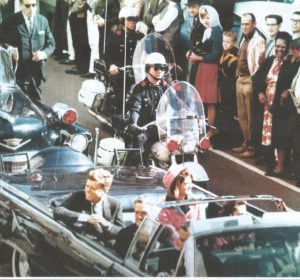
President Kennedy’s Fatal Head Wound
The medical professionals at Parkland Hospital’s emergency room discovered two wounds during their initial examination of President Kennedy. The first and most obvious to them, was an entry wound to the president’s throat.
The second and most damaging wound was an exit wound on the back right of JFK’s head. It was this second wound which they judged caused the president to lose almost a third of his brain.
Dr. Robert McClelland attached this crude freehand drawing to his Parkland Hospital emergency room report. He testified that JFK was hit on the right front of his head with an exit wound in the back of his head. His testimony to the Warren Commission was supported by Dr. Kemp Clark, Dr. Paul Peters, Dr. Ronald Jones, Dr. Gene Akin in their sworn testimony. All of these medical professionals testified that this head wound was an exit wound.
At the scene of the murder, Patrolman Bobby Hargis testified that his uniform and motorcycle windshield was covered with blood and flesh. In the attached photo, Patrolman is seen the rear and left of President Kennedy.

Bill and Gayle Newman were standing along the parade route. They reported to the Dallas police on November 24, 1963 that they saw a bullet hit President Kennedy on the front right of his head
The Zapruder film clearly shows a bullet hitting the president’s head in the right front. Thirty eight onlookers testified to Warren Commission personnel that they heard gunfire coming from the Grassy Knoll along Elm Street, behind them.
Never-the-less, the FBI Report and later, the Warren Commission Report insisted that all shots came from behind the President and were all fired by Lee Harvey Oswald from the Book Depository building. In his Warren Commission testimony, FBI Director J. Edgar Hoover testified, “there is not one scintilla of proof that there was a conspiracy (more than one assassin), foreign or domestic.”
Despite the testimony of the above professionals and others (see previous blog) to the frontal wounds to the throat and the head, Congressman Gerald Ford. a member of the Warren Commission, wrote for Life Magazine in October 1864, dismissing the existence of either wound.
“There is no evidence of a second gunman, or of other shots or other guns.”